 | –≠–ª–µ–∫—Ç—Ä–æ–Ω–Ω—ã–π –∫–æ–º–ø–æ–Ω–µ–Ω—Ç: CS5340-CZ | –°–∫–∞—á–∞—Ç—å:  PDF PDF  ZIP ZIP |

Advance Product Information
This document contains information for a new product.
Cirrus Logic reserves the right to modify this product without notice.
1
Copyright
© Cirrus Logic, Inc. 2003
(All Rights Reserved)
www.cirrus.com
CS5340
101 dB, 192 kHz, Multi-Bit Audio A/D Converter
Features
Advanced multi-bit Delta-Sigma architecture
24-bit conversion
Supports all audio sample rates including
192 kHz
101 dB Dynamic Range at 5V
-94 dB THD+N
High pass filter to remove DC offsets
Analog/digital core supplies from 3.3V to 5V
Supports logic levels between 2.5V and 5V
Linear phase digital anti-alias filtering
Auto-mode selection
Pin compatible with the CS5341
General Description
The CS5340 is a complete analog-to-digital converter for
digital audio systems. It performs sampling, analog-to-
digital conversion and anti-alias filtering, generating
24-bit values for both left and right inputs in serial form at
sample rates up to 200 kHz per channel.
The CS5340 uses a 5th-order, multi-bit Delta-Sigma
modulator followed by digital filtering and decimation,
which removes the need for an external anti-alias filter.
The CS5340 is ideal for audio systems requiring wide dy-
namic range, negligible distortion and low noise, such as
set-top boxes, DVD-karaoke players, DVD recorders,
A/V receivers, and automotive applications.
ORDERING INFORMATION
CS5340-CZ
-10∞ to 70∞ C
16-pin TSSOP
CDB5340
Evaluation Board
Voltage Reference
Serial Output Interface
Digital
Filter
High
Pass
Filter
High
Pass
Filter
Decimation
Digital
Filter
Decimation
DAC
-
+
S/H
DAC
-
+
S/H
AINR
SCLK
SDOUT
MCLK
RST
VQ
LRCK
AINL
FILT+
M0
REFGND
V
L
Q
LP Filter
Q
LP Filter
M1
VD
GND
VA
3.3V - 5.0V
3.3V - 5.0V
2.5V - 5.0V
FEB `03
DS601A1

CS5340
2
TABLE OF CONTENTS
1 CHARACTERISTICS AND SPECIFICATIONS ......................................................................... 4
SPECIFIED OPERATING CONDITIONS ................................................................................. 4
ABSOLUTE MAXIMUM RATINGS ........................................................................................... 4
ANALOG CHARACTERISTICS (CS5340-CZ).......................................................................... 5
DIGITAL FILTER CHARACTERISTICS.................................................................................... 7
DC ELECTRICAL CHARACTERISTICS................................................................................. 10
DIGITAL CHARACTERISTICS ............................................................................................... 10
THERMAL CHARACTERISTICS............................................................................................ 10
SWITCHING CHARACTERISTICS - SERIAL AUDIO PORT ................................................. 11
2 PIN DESCRIPTION ................................................................................................................. 13
3 TYPICAL CONNECTION DIAGRAM ....................................................................................... 14
4 APPLICATIONS ....................................................................................................................... 15
4.1 Single, Double, and Quad Speed Modes ......................................................................... 15
4.2 Operation as Either a Clock Master or Slave ................................................................... 15
4.3 Serial Audio Interface ....................................................................................................... 17
4.4 Power-up Sequence ........................................................................................................ 18
4.5 Analog Connections ......................................................................................................... 18
4.6 Grounding and Power Supply Decoupling ....................................................................... 19
4.7 Synchronization of Multiple Devices ................................................................................ 19
5 PARAMETER DEFINITIONS ................................................................................................... 20
6 PACKAGE DIMENSIONS ....................................................................................................... 21
Contacting Cirrus Logic Support
For all product questions and inquiries contact a Cirrus Logic Sales Representative.
To find one nearest you go to
www.cirrus.com/
IMPORTANT NOTICE
"Preliminary" product information describes products that are in production, but for which full characterization data is not yet available. "Advance" product informa-
tion describes products that are in development and subject to development changes. Cirrus Logic, Inc. and its subsidiaries ("Cirrus") believe that the information
contained in this document is accurate and reliable. However, the information is subject to change without notice and is provided "AS IS" without warranty of any
kind (express or implied). Customers are advised to obtain the latest version of relevant information to verify, before placing orders, that information being relied
on is current and complete. All products are sold subject to the terms and conditions of sale supplied at the time of order acknowledgment, including those pertaining
to warranty, patent infringement, and limitation of liability. No responsibility is assumed by Cirrus for the use of this information, including use of this information as
the basis for manufacture or sale of any items, or for infringement of patents or other rights of third parties. This document is the property of Cirrus and by furnishing
this information, Cirrus grants no license, express or implied under any patents, mask work rights, copyrights, trademarks, trade secrets or other intellectual property
rights. Cirrus owns the copyrights associated with the information contained herein and gives consent for copies to be made of the information only for use within
your organization with respect to Cirrus integrated circuits or other parts of Cirrus. This consent does not extend to other copying such as copying for general dis-
tribution, advertising or promotional purposes, or for creating any work for resale.
An export permit needs to be obtained from the competent authorities of the Japanese Government if any of the products or technologies described in this material
and controlled under the "Foreign Exchange and Foreign Trade Law" is to be exported or taken out of Japan. An export license and/or quota needs to be obtained
from the competent authorities of the Chinese Government if any of the products or technologies described in this material is subject to the PRC Foreign Trade
Law and is to be exported or taken out of the PRC.
CERTAIN APPLICATIONS USING SEMICONDUCTOR PRODUCTS MAY INVOLVE POTENTIAL RISKS OF DEATH, PERSONAL INJURY, OR SEVERE PROP-
ERTY OR ENVIRONMENTAL DAMAGE ("CRITICAL APPLICATIONS"). CIRRUS PRODUCTS ARE NOT DESIGNED, AUTHORIZED, OR WARRANTED TO BE
SUITABLE FOR USE IN LIFE-SUPPORT DEVICES OR SYSTEMS OR OTHER CRITICAL APPLICATIONS. INCLUSION OF CIRRUS PRODUCTS IN SUCH AP-
PLICATIONS IS UNDERSTOOD TO BE FULLY AT THE CUSTOMER'S RISK.
Cirrus Logic, Cirrus and the Cirrus Logic logo designs are trademarks of Cirrus Logic, Inc. All other brand and product names in this document may be trademarks
or service marks of their respective owners.
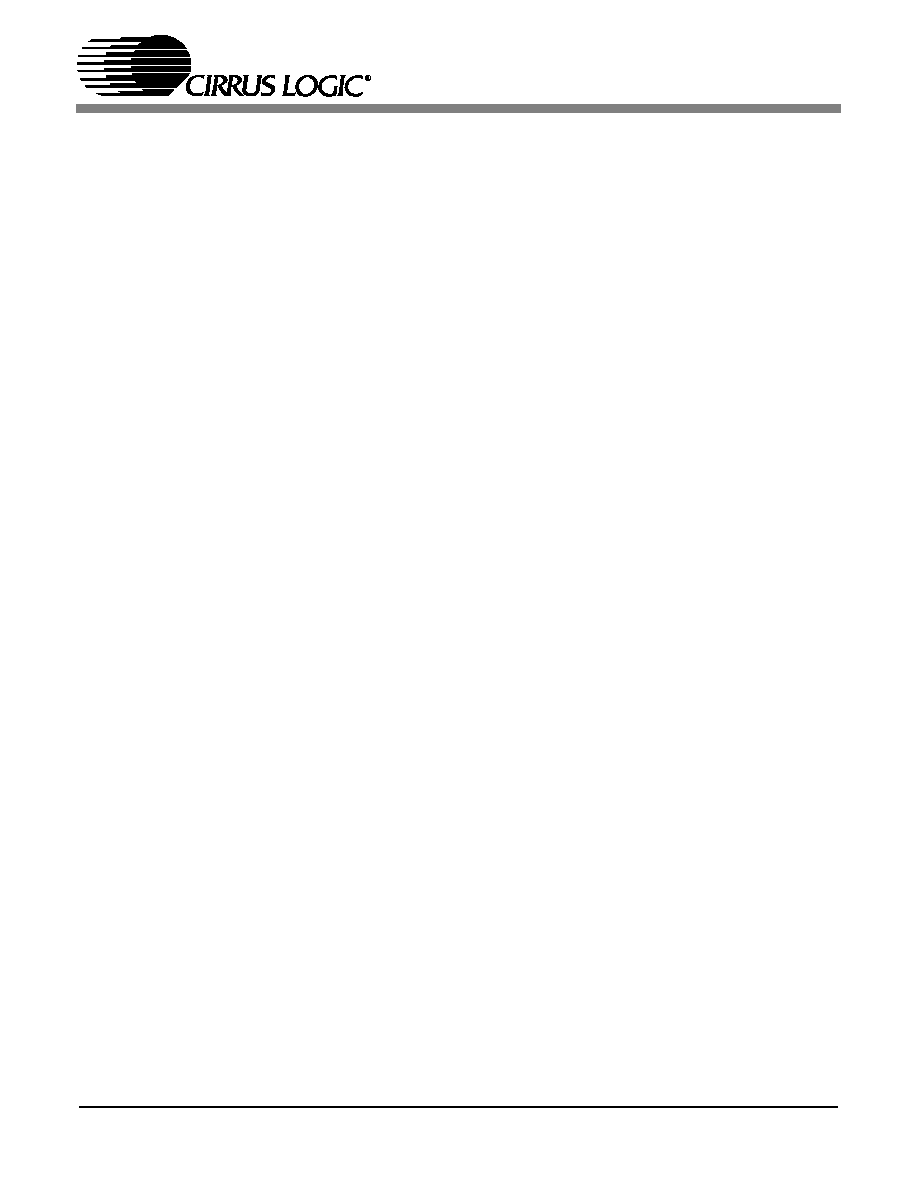
CS5340
3
LIST OF FIGURES
Figure 1. Single Speed Mode Stopband Rejection ......................................................................... 8
Figure 2. Single Speed Mode Stopband Rejection ......................................................................... 8
Figure 3. Single Speed Mode Transition Band (Detail)................................................................... 8
Figure 4. Single Speed Mode Passband Ripple ............................................................................. 8
Figure 5. Double Speed Mode Stopband Rejection........................................................................ 8
Figure 6. Double Speed Mode Stopband Rejection........................................................................ 8
Figure 7. Double Speed Mode Transition Band (Detail) ................................................................. 9
Figure 8. Double Speed Mode Passband Ripple ............................................................................ 9
Figure 9. Quad Speed Mode Stopband Rejection .......................................................................... 9
Figure 10. Quad Speed Mode Stopband Rejection ........................................................................ 9
Figure 11. Quad Speed Mode Transition Band (Detail) .................................................................. 9
Figure 12. Quad Speed Mode Passband Ripple............................................................................. 9
Figure 13. Master Mode, Left Justified SAI ................................................................................... 12
Figure 14. Slave Mode, Left Justified SAI ..................................................................................... 12
Figure 15. Master Mode, I
2
S SAI .................................................................................................. 12
Figure 16. Slave Mode, I
2
S SAI .................................................................................................... 12
Figure 17. Typical Connection Diagram ........................................................................................ 14
Figure 18. CS5340 Master Mode Clocking ................................................................................... 16
Figure 19. Left-Justified Serial Audio Interface ............................................................................. 18
Figure 20. I
2
S Serial Audio Interface............................................................................................. 18
Figure 21. CS5340 Recommended Analog Input Buffer............................................................... 19
LIST OF TABLES
Table 1. CS5340 Mode Control..................................................................................................... 15
Table 2. CS5340 Auto-Detect ....................................................................................................... 16
Table 3. Master Clock (MCLK) Ratios........................................................................................... 17
Table 4. Master Clock (MCLK) Frequencies for Standard Audio Sample Rates .......................... 17

CS5340
4
1
CHARACTERISTICS AND SPECIFICATIONS
(All Min/Max characteristics and specifications are guaranteed over the Specified Operating Conditions. Typical
performance characteristics and specifications are derived from measurements taken at typical supply voltages
and T
A
= 25
∞C.)
SPECIFIED OPERATING CONDITIONS
(GND = 0 V, all voltages with respect to 0 V.)
Notes: 1. This part is specified at typical analog voltages of 3.3 V and 5.0 V. See Analog Characteristics (CS5340-
CZ), below, for details.
ABSOLUTE MAXIMUM RATINGS
(GND = 0V, All voltages with respect to ground.) (Note 4)
Notes: 2. Any pin except supplies. Transient currents of up to ±100 mA on the analog input pins will not cause SRC
latch-up.
3. The maximum over/under voltage is limited by the input current.
4. Operation beyond these limits may result in permanent damage to the device.
Normal operation is not guaranteed at these extremes.
Parameter
Symbol
Min
Typ
Max
Unit
Power Supplies
Analog
Digital
Logic
VA
VD
VL
3.1
3.1
2.35
(Note 1)
3.3
3.3
5.25
5.25
5.25
V
V
V
Ambient Operating Temperature
Commercial (-CZ)
T
AC
-10
-
70
∞C
Parameter
Symbol
Min
Max
Units
DC Power Supplies:
Analog
Logic
Digital
VA
VL
VD
-0.3
-0.3
-0.3
+6.0
+6.0
+6.0
V
V
V
Input Current
(Note 2)
I
in
-
±10
mA
Analog Input Voltage
(Note 3)
V
IN
GND-0.7
VA+0.7
V
Digital Input Voltage
(Note 3)
V
IND
-0.7
VL+0.7
V
Ambient Operating Temperature (Power Applied)
T
A
-50
+95
∞C
Storage Temperature
T
stg
-65
+150
∞C

CS5340
5
ANALOG CHARACTERISTICS (CS5340-CZ)
Test conditions (unless otherwise specified):
Input test signal is a 1 kHz sine wave; measurement bandwidth is 10 Hz to 20 kHz.
Parameter
Symbol
Min
Typ
Max
Unit
VA = 3.3 V
Single Speed Mode
Fs = 48 kHz
Dynamic Range
A-weighted
unweighted
92
89
98
95
-
-
dB
dB
Total Harmonic Distortion + Noise
(Note 5)
-1 dB
-20 dB
-60 dB
THD+N
-
-
-
-91
-75
-35
-85
-
-
dB
dB
dB
Double Speed Mode
Fs = 96 kHz
Dynamic Range
A-weighted
unweighted
40 kHz bandwidth unweighted
92
89
-
98
95
92
-
-
-
dB
dB
dB
Total Harmonic Distortion + Noise
(Note 5)
-1 dB
-20 dB
-60 dB
40 kHz bandwidth
-1 dB
THD+N
-
-
-
-
-91
-75
-35
-85
-85
-
-
-
dB
dB
dB
dB
Quad Speed Mode
Fs = 192 kHz
Dynamic Range
A-weighted
unweighted
40 kHz bandwidth unweighted
92
89
-
98
95
92
-
-
-
dB
dB
dB
Total Harmonic Distortion + Noise
(Note 5)
-1 dB
-20 dB
-60 dB
40 kHz bandwidth
-1 dB
THD+N
-
-
-
-
-91
-75
-35
-85
-85
-
-
-
dB
dB
dB
dB
VA = 5.0 V
Single Speed Mode
Fs = 48 kHz
Dynamic Range
A-weighted
unweighted
95
92
101
98
-
-
dB
dB
Total Harmonic Distortion + Noise
(Note 5)
-1 dB
-20 dB
-60 dB
THD+N
-
-
-
-94
-78
-38
-88
-
-
dB
dB
dB
Double Speed Mode
Fs = 96 kHz
Dynamic Range
A-weighted
unweighted
40 kHz bandwidth unweighted
95
92
-
101
98
95
-
-
-
dB
dB
dB
Total Harmonic Distortion + Noise
(Note 5)
-1 dB
-20 dB
-60 dB
40 kHz bandwidth
-1 dB
THD+N
-
-
-
-
-94
-78
-38
-91
-88
-
-
-
dB
dB
dB
dB
Quad Speed Mode
Fs = 192 kHz

CS5340
6
Note:
5. Referred to the typical full-scale input voltage
Dynamic Range
A-weighted
unweighted
40 kHz bandwidth unweighted
95
92
-
101
98
95
-
-
-
dB
dB
dB
Total Harmonic Distortion + Noise
(Note 5)
-1 dB
-20 dB
-60 dB
40 kHz bandwidth
-1 dB
THD+N
-
-
-
-
-94
-78
-38
-91
-88
-
-
-
dB
dB
dB
dB
Dynamic Performance for All Modes
Interchannel Isolation
-
70
-
dB
Interchannel Phase Deviation
-
0.0001
-
Degree
DC Accuracy
Interchannel Gain Mismatch
-
0.1
-
dB
Gain Error
-
±
5
%
Gain Drift
-
±
100
-
ppm/∞C
Analog Input Characteristics
Full-scale Input Voltage
0.53*VA
0.56*VA
0.59*VA
Vpp
Input Impedance
18
-
-
k

CS5340
7
DIGITAL FILTER CHARACTERISTICS
Note:
6. Response shown is for Fs equal to 48 kHz. Filter characteristics scale with Fs.
Parameter
Symbol
Min
Typ
Max
Unit
Single Speed Mode (2 kHz to 50 kHz sample rates)
Passband
(-0.1 dB)
0
-
23.5
kHz
Passband Ripple
-
-
0.035
dB
Stopband
27.3
-
-
kHz
Stopband Attenuation
70
-
-
dB
Total Group Delay (Fs = Output Sample Rate)
t
gd
-
12/Fs
-
s
Group Delay Variation vs. Frequency
t
gd
-
-
0.0
µs
Double Speed Mode (50 kHz to 100 kHz sample rates)
Passband
(-0.1 dB)
0
-
47
kHz
Passband Ripple
-
-
±0.025
dB
Stopband
53.8
-
-
kHz
Stopband Attenuation
69
-
-
dB
Total Group Delay (Fs = Output Sample Rate)
t
gd
-
9/Fs
-
s
Group Delay Variation vs. Frequency
t
gd
-
-
0.0
µs
Quad Speed Mode (100 kHz to 200 kHz sample rates)
Passband
(-0.1 dB)
0
-
50
kHz
Passband Ripple
-
-
±0.025
dB
Stopband
96
-
-
kHz
Stopband Attenuation
60
-
-
dB
Total Group Delay (Fs = Output Sample Rate)
t
gd
-
5/Fs
-
s
Group Delay Variation vs. Frequency
t
gd
-
-
0.0
µs
High Pass Filter Characteristics
Frequency Response
-3.0 dB
-0.13 dB
(Note 6)
-
1
20
-
-
Hz
Hz
Phase Deviation
@ 20Hz
(Note 6)
-
10
-
Deg
Passband Ripple
-
-
0
dB

CS5340
8
Figure 1. Single Speed Mode Stopband Rejection
Figure 2. Single Speed Mode Stopband Rejection
Figure 3. Single Speed Mode Transition Band (Detail)
Figure 4. Single Speed Mode Passband Ripple
Figure 5. Double Speed Mode Stopband Rejection
Figure 6. Double Speed Mode Stopband Rejection
-140
-130
-120
-110
-100
-90
-80
-70
-60
-50
-40
-30
-20
-10
0
0.0
0.1
0.2
0.3
0.4
0.5
0.6
0.7
0.8
0.9
1.0
Frequency (norm alized to Fs)
A
m
pl
i
t
ude
(
d
B
)
-140
-130
-120
-110
-100
-90
-80
-70
-60
-50
-40
-30
-20
-10
0
0.40
0.42
0.44
0.46 0.48 0.50
0.52
0.54
0.56
0.58
0.60
Frequency (norm alized to Fs)
A
m
pl
i
t
ude
(
d
B
)
-10
-9
-8
-7
-6
-5
-4
-3
-2
-1
0
0.45
0.46 0.47
0.48
0.49
0.5
0.51
0.52
0.53
0.54
0.55
Frequency (norm alized to Fs)
A
m
pl
i
t
ude
(
d
B
)
-0.10
-0.08
-0.06
-0.04
-0.02
0.00
0.02
0.04
0.06
0.08
0.10
0
0.05
0.1
0.15
0.2
0.25
0.3
0.35
0.4
0.45
0.5
Frequency (norm alized to Fs)
A
m
pl
i
t
ude
(
d
B
)
-140
-130
-120
-110
-100
-90
-80
-70
-60
-50
-40
-30
-20
-10
0
0.0
0.1
0.2
0.3
0.4
0.5
0.6
0.7
0.8
0.9
1.0
Frequency (norm alized to Fs)
A
m
pl
i
t
ude
(
d
B
)
-140
-130
-120
-110
-100
-90
-80
-70
-60
-50
-40
-30
-20
-10
0
0.40
0.42
0.44
0.46 0.48 0.50
0.52
0.54
0.56
0.58
0.60
Frequency (norm alized to Fs)
A
m
pl
i
t
ude
(
d
B
)

CS5340
9
Figure 7. Double Speed Mode Transition Band (Detail)
Figure 8. Double Speed Mode Passband Ripple
Figure 9. Quad Speed Mode Stopband Rejection
Figure 10. Quad Speed Mode Stopband Rejection
Figure 11. Quad Speed Mode Transition Band (Detail)
Figure 12. Quad Speed Mode Passband Ripple
-10
-9
-8
-7
-6
-5
-4
-3
-2
-1
0
0.46
0.47
0.48
0.49
0.50
0.51
0.52
Frequency (norm alized to Fs)
A
m
pl
i
t
ude
(
d
B
)
-0.10
-0.08
-0.06
-0.04
-0.02
0.00
0.02
0.04
0.06
0.08
0.10
0.00 0.05
0.10
0.15
0.20
0.25
0.30
0.35 0.40
0.45
0.50
Frequency (norm alized to Fs)
A
m
pl
i
t
ude
(
d
B
)
-140
-130
-120
-110
-100
-90
-80
-70
-60
-50
-40
-30
-20
-10
0
0.0
0.1
0.2
0.3
0.4
0.5
0.6
0.7
0.8
0.9
1.0
Frequency (norm alized to Fs)
A
m
pl
i
t
ude
(
d
B
)
-140
-130
-120
-110
-100
-90
-80
-70
-60
-50
-40
-30
-20
-10
0
0.20 0.25 0.30 0.35 0.40 0.45 0.50 0.55 0.60 0.65 0.70 0.75 0.80 0.85
Frequency (norm alized to Fs)
A
m
pl
i
t
ude
(
d
B
)
-10
-9
-8
-7
-6
-5
-4
-3
-2
-1
0
0.10
0.15
0.20
0.25
0.30
0.35
0.40
0.45
0.50
Frequency (norm alized to Fs)
A
m
pl
i
t
ude
(
d
B
)
-0.10
-0.08
-0.06
-0.04
-0.02
0.00
0.02
0.04
0.06
0.08
0.10
0.00 0.03 0.05 0.08 0.10
0.13 0.15 0.18 0.20 0.23 0.25 0.28
Frequency (norm alized to Fs)
A
m
pl
i
t
ude
(
d
B
)

CS5340
10
DC ELECTRICAL CHARACTERISTICS
(GND = 0 V, all voltages with respect to 0V.
MCLK=12.288 MHz; Master Mode)
Notes: 7. Power Down Mode is defined as RST = Low with all clocks and data lines held static.
8. Valid with the recommended capacitor values on FILT+ and VQ as shown in the Typical Connection
Diagram.
DIGITAL CHARACTERISTICS
THERMAL CHARACTERISTICS
Parameter
Symbol
Min
Typ
Max
Unit
DC Power Supplies:
Positive Analog
Positive Digital
Positive Logic
VA
VD
VL
3.1
3.1
2.35
-
-
-
5.25
5.25
5.25
V
V
V
Power Supply Current
VA = 5 V
(Normal Operation)
VA = 3.3 V
VL,VD = 5 V
VL,VD = 3.3 V
I
A
I
A
I
D
I
D
-
-
-
-
21
18.2
15
9
23.1
20
16.5
10
mA
mA
mA
mA
Power Supply Current
VA = 5 V
(Power-Down Mode) (Note 7)
VL,VD=5 V
I
A
I
D
-
-
1.5
0.4
-
-
mA
mA
Power Consumption
VL, VD, VA = 5 V
(Normal Operation)
VL, VD, VA = 3.3 V
(Power-Down Mode)
-
-
-
-
-
-
180
90
9.5
198
100
-
mW
mW
mW
Power Supply Rejection Ratio
(1 kHz)
(Note 8)
PSRR
-
65
-
dB
V
Q
Nominal Voltage
Output Impedance
-
-
VA
˜
2
100
-
-
V
Filt+ Nominal Voltage
Output Impedance
Maximum allowable DC current source/sink
-
-
-
VA
18
0.01
-
-
-
V
k
mA
Parameter
Symbol
Min
Typ
Max
Units
High-Level Input Voltage
(% of VL)
V
IH
70%
-
-
V
Low-Level Input Voltage
(% of VL)
V
IL
-
-
30%
V
High-Level Output Voltage at I
o
= 100
µA
(% of VL)
V
OH
70%
-
-
V
Low-Level Output Voltage at I
o
=100
µA
(% of VL)
V
OL
-
-
15%
V
Input Leakage Current
I
in
-
-
±10
µA
Parameter
Symbol
Min
Typ
Max
Unit
Allowable Junction Temperature
-
-
135
∞C
Junction to Ambient Thermal Impedance
JA
-
75
-
∞C/W
Ambient Operating Temperature (Power Applied)
T
A
-10
-
+70
∞C

CS5340
11
SWITCHING CHARACTERISTICS - SERIAL AUDIO PORT
(Logic "0" = GND = 0 V;
Logic "1" = VL, C
L
= 20 pF)
Parameter
Symbol
Min
Typ
Max
Unit
Output Sample Rate (Master Mode) Single Speed Mode
Double Speed Mode
Quad Speed Mode
Fs
Fs
Fs
2
50
100
-
-
-
50
100
200
kHz
kHz
kHz
MCLK Specifications
MCLK Period
t
clkw
39
-
1953
ns
MCLK Pulse Width High
t
clkh
15
-
-
ns
MCLK Pulse Width Low
t
clkl
15
-
-
ns
Master Mode
SCLK falling to LRCK
t
mslr
-20
-
20
ns
SCLK falling to SDOUT valid
t
sdo
0
-
32
ns
SCLK Duty Cycle
-
50
-
%
SCLK Output Frequency
-
50
-
%
Slave Mode
Single Speed
Output Sample Rate
Fs
4
-
50
kHz
LRCK Duty Cycle
40
50
60
%
SCLK Period
t
sclkw
156
-
-
ns
SCLK High/Low
t
sclkhl
32
-
-
ns
SCLK falling to SDOUT valid
t
dss
-
-
32
ns
SCLK falling to LRCK edge
t
slrd
-20
-
20
ns
Double Speed
Output Sample Rate
Fs
84
-
100
kHz
LRCK Duty Cycle
40
50
60
%
SCLK Period
t
sclkw
156
-
-
ns
SCLK High/Low
t
sclkhl
32
-
-
ns
SCLK falling to SDOUT valid
t
dss
-
-
32
ns
SCLK falling to LRCK edge
t
slrd
-20
-
20
ns
Quad Speed
Output Sample Rate
Fs
170
-
200
kHz
LRCK Duty Cycle
40
50
60
%
SCLK Period
t
sclkw
78
-
-
ns
SCLK High/Low
t
sclkhl
32
-
-
ns
SCLK falling to SDOUT valid
t
dss
-
-
32
ns
SCLK falling to LRCK edge
t
slrd
-10
-
10
ns
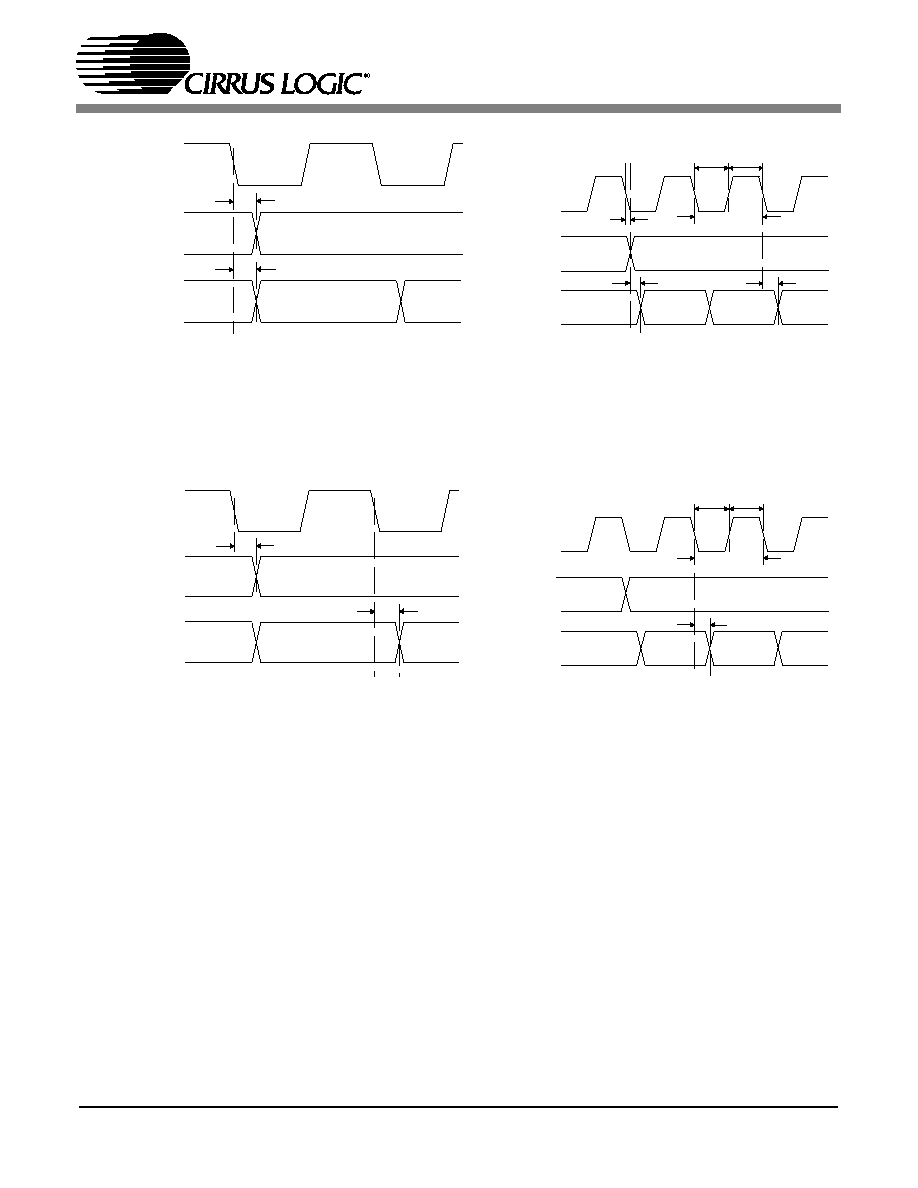
CS5340
12
SCLK output
tmslr
SDOUT
tsdo
LRCK output
MSB
MSB-1
SCLK input
LRCK input
sclkl
t
dss
t
MSB
MSB-1
MSB-2
lrdss
t
sclkh
t
tsclkw
SDOUT
s rd
l
t
Figure 13. Master Mode, Left Justified SAI
Figure 14. Slave Mode, Left Justified SAI
SCLK output
tmslr
tsdo
LRCK output
MSB
SDOUT
SCLK input
LRCK input
sclkl
t
dss
t
MSB
MSB-1
sclkh
t
t
sclkw
SDOUT
Figure 15. Master Mode, I
2
S SAI
Figure 16. Slave Mode, I
2
S SAI
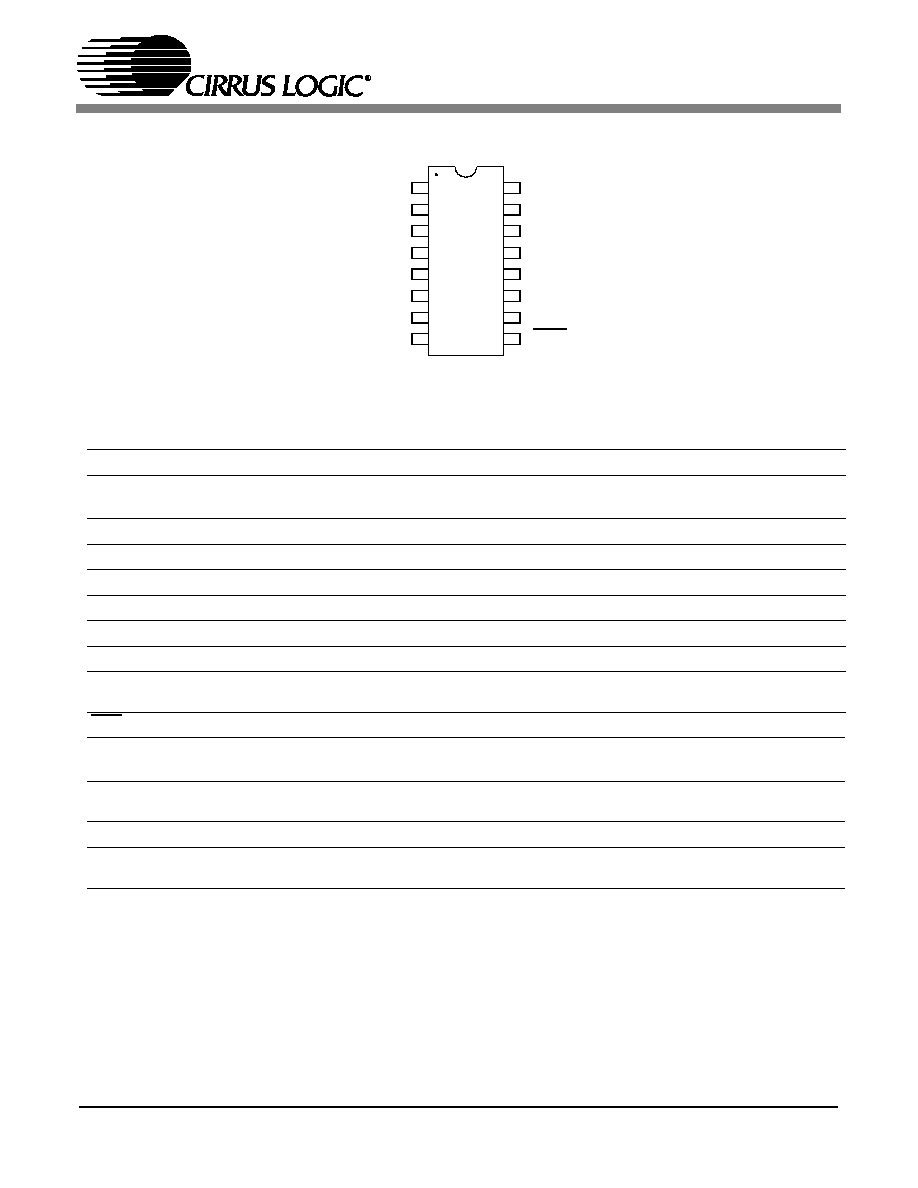
CS5340
13
2
PIN DESCRIPTION
Pin Name
#
Pin Description
M0
M1
1
16
Mode Selection (Input) - Determines the operational mode of the device.
MCLK
2
Master Clock (Input) - Clock source for the delta-sigma modulator and digital filters.
VL
3
Logic Power (Input) - Positive power for the digital input/output.
SDOUT
4
Serial Audio Data Output (Output) - Output for two's complement serial audio data.
GND
5,14
Ground (Input) - Ground reference. Must be connected to analog ground.
VD
6
Digital Power (Input) - Positive power supply for the digital section.
SCLK
7
Serial Clock (Input/Output) - Serial clock for the serial audio interface.
LRCK
8
Left Right Clock (Input/Output) - Determines which channel, Left or Right, is currently
active on the serial audio data line.
RST
9
Reset (Input) - The device enters a low power mode when low.
AINL
AINR
10
12
Analog Input (Input) - The full scale analog input level is specified in the Analog Charac-
teristics specification table.
VQ
11
Quiescent Voltage (Output) - Filter connection for the internal quiescent
reference voltage.
VA
13
Analog Power (Input) - Positive power supply for the analog section.
FILT+
15
Positive Voltage Reference (Output) - Positive reference voltage for the internal
sampling circuits.
M0
M1
MCLK
FILT+
VL
REF_GND
SDOUT
VA
GND
AINR
VD
VQ
SCLK
AINL
LRCK
RST
1
2
3
4
5
6
7
8
5
1
2
6
16
15
14
13
12
11
10
9
1
2
3
4
5
6
7
8
5
1
2
6
16
15
14
13
12
11
10
9
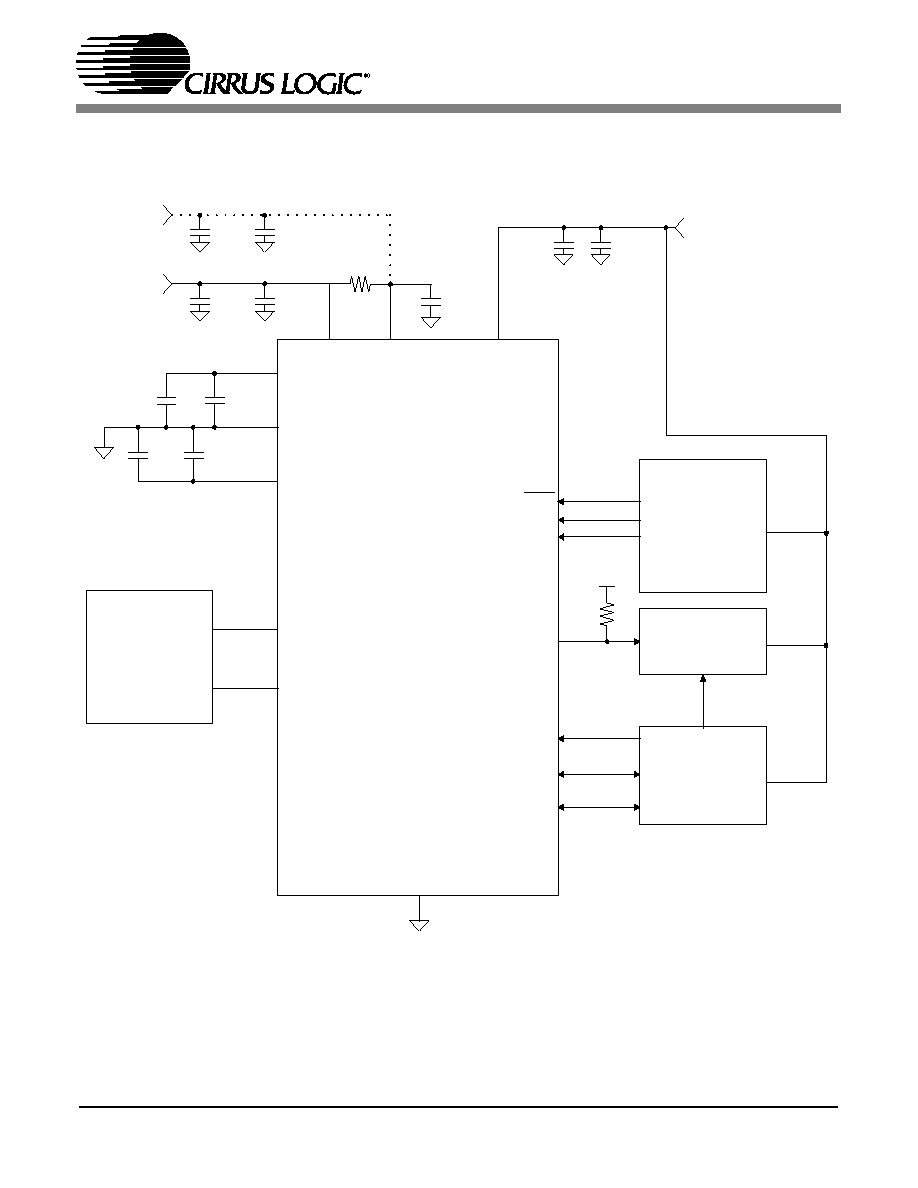
CS5340
14
3
TYPICAL CONNECTION DIAGRAM
FILT+
V
0.1
µF
A/D CONVERTER
SCLK
CS5340
MCLK
VQ
1
µF
+
RST
VA
L
1
µF
2.5V to 5V
1
µF
+
+
SDOUT
GND
LRCK
Power Down
and Mode
Settings
Audio Data
Processor
Timing Logic
and Clock
0.1
µF
0.1
µF
0.1
µF
REFGND
1µF
+
AINL
AINR
3.3V to 5V
1
µF
+
0.1
µF
3.3V to 5V
5.1
VD
0.1
µF
10k
VL or GND
* Pull-up to VL for I
2
S
Pull-down to GND for LJ
*
M0
M1
Analog Input Buffer
Figure 21
**
** Resistor may only be
used if VD is derived from
VA. If used, do not drive
any other logic from VD
Figure 17. Typical Connection Diagram

CS5340
15
4 APPLICATIONS
4.1
Single, Double, and Quad Speed Modes
The CS5340 can support output sample rates from 2 kHz to 200 kHz when operating as a clock master (see Section
4.2 for more information). By definition, Single Speed mode is defined as output sample rates between 2 kHz and
50 kHz. Double Speed mode is defined as output sample rates between 50 kHz and 100 kHz, and Quad Speed
mode is defined as output sample rates between 100 kHz and 200 kHz.
The output sample rate ranges listed above are how the speed modes are defined, and do not imply an absolute
sample rate specification. If the absolute frequency of the sample rate is increased above that defined for a given
speed mode, the analog performance will degrade. This is due to the fact that the analog input is sampling faster
than designed and therefore does not have as much time to settle, which adds distortion.
4.2
Operation as Either a Clock Master or Slave
The CS5340 supports operation as either a clock master or slave. As a clock master, the LRCK and SCLK pins are
outputs with the left/right and serial clocks synchronously generated on-chip. As a clock slave, the LRCK and SCLK
pins are inputs and require the left/right and serial clocks to be externally generated. The selection of clock master
or slave is made via the Mode pins as shown in Table 1.
4.2.1
Operation as a Clock Master
As a clock master, LRCK and SCLK operate as outputs. The left/right and serial clocks are internally derived from
the master clock with the left/right clock equal to Fs and the serial clock equal to 64x Fs, as shown in Figure 18.
M1(Pin 16)
M0(Pin 1)
MODE
Output Sample Rate (Fs)
0
0
Clock Master, Single Speed Mode
2 kHz - 50 kHz
0
1
Clock Master, Double Speed Mode
50 kHz - 100 kHz
1
0
Clock Master, Quad Speed Mode
100 kHz - 200 kHz
1
1
Clock Slave, All Speed Modes
Refer to Table 2
Table 1. CS5340 Mode Control

CS5340
16
4.2.2
Operation as a Clock Slave
LRCK and SCLK operate as inputs in clock slave mode. It is recommended that the left/right clock be
synchronously derived from the master clock and must be equal to Fs. It is also recommended that the serial clock
be synchronously derived from the master clock and be equal to 64x Fs to maximize system performance.
A unique feature of the CS5340 is the automatic selection of either Single, Double or Quad speed mode when op-
erating as a clock slave. The auto-mode select feature negates the need to configure the Mode pins to correspond
to the desired mode. The auto-mode selection feature supports all standard audio sample rates from 32 to 200 kHz.
However, there are ranges of non-standard audio sample rates that are not supported when operated as a clock
slave. Please refer to Table 2.
˜ 128
˜ 256
˜ 64
M0
M1
LRCK Output
(Equal to Fs)
Single
Speed
Quad
Speed
Double
Speed
00
01
10
˜ 2
˜ 4
˜ 1
SCLK Output
Single
Speed
Quad
Speed
Double
Speed
00
01
10
˜ 2
˜ 1
0
1
MCLK
Auto-Select
Figure 18. CS5340 Master Mode Clocking
Output Sample Rate (Fs)
MODE
4 kHz - 50 kHz
Single Speed Mode
84 kHz - 100 kHz
Double Speed Mode
170 kHz - 200 kHz
Quad Speed Mode
Table 2. CS5340 Auto-Detect
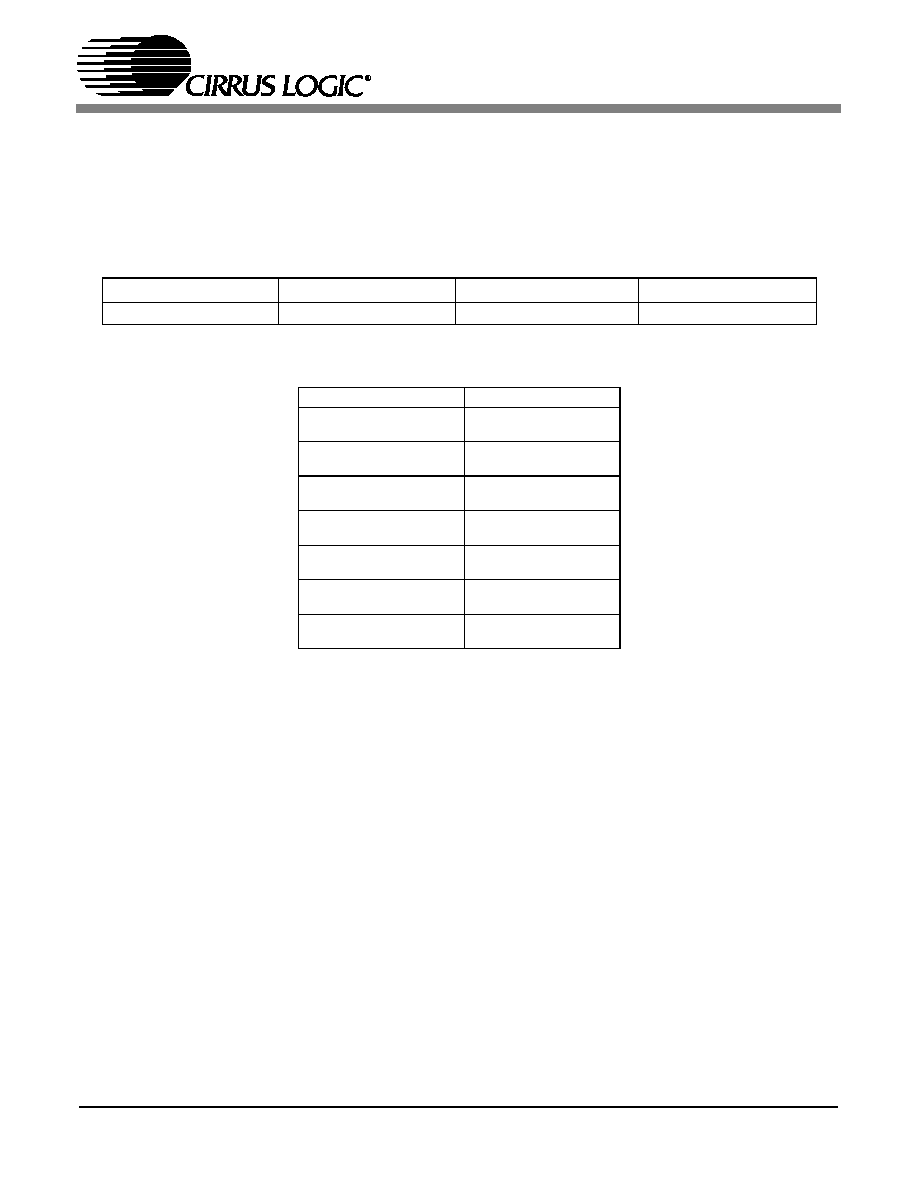
CS5340
17
4.2.3
Master Clock
The CS5340 requires a Master clock (MCLK) which runs the internal sampling circuits and digital filters. There is
also an internal MCLK divider which is automatically activated based on the speed mode and frequency of the
MCLK. Table 3 shows a listing of the external MCLK/LRCK ratios that are required. Table 4 lists some common au-
dio output sample rates and the required MCLK frequency. Please note that not all of the listed sample rates are
supported in clock slave mode. Refer to Section 4.2.2 for details.
4.3
Serial Audio Interface
The CS5340 supports both I
2
S and Left Justified serial audio formats. Upon start-up, the CS5340 will detect the logic
level on SDOUT (pin 4). A 10k pull-up to VL is needed to select I
2
S format, and a 10k pull-down to GND is needed
to select Left Justified format. Please see Figures 13 through 16 on page 12, for more information on the required
timing for the two serial audio interface formats.
Single Speed Mode
Double Speed Mode
Quad Speed Mode
MCLK/LRCK Ratio
256x, 512x
128x, 256x
128x
Table 3. Master Clock (MCLK) Ratios
SAMPLE RATE (kHz)
MCLK (MHz)
32
8.192
16.384
44.1
11.2896
22.5792
48
12.288
24.576
64
8.192
16.384
88.2
11.2896
22.5792
96
12.288
24.576
192
12.288
24.576
Table 4. Master Clock (MCLK) Frequencies for Standard Audio Sample Rates

CS5340
18
4.4
Power-up Sequence
Reliable power-up can be accomplished by keeping the device in reset until the power supplies, clocks and config-
uration pins are stable. It is also recommended that reset be enabled if the analog or digital supplies drop below the
minimum specified operating voltages to prevent power glitch related issues.
4.5
Analog Connections
The analog modulator samples the input at 6.144 MHz. The digital filter will reject signals within the stopband of the
filter. However, there is no rejection for input signals which are multiples of the input sampling frequency
(n
*
6.144 MHz), where n=0,1,2,... Refer to Figure 21 on page 19 which shows the suggested filter that will attenuate
any noise energy at 6.144 MHz, in addition to providing the optimum source impedance for the modulators. The use
of capacitors which have a large voltage coefficient (such as general purpose ceramics) must be avoided since
these can degrade signal linearity.
S D AT A
2 3 2 2
7
6
23 2 2
S C L K
L R C K
2 3 2 2
5
4
3
2
1
0
8
7
6
5
4
3
2
1
0
8
9
9
L e ft C ha n ne l
R ig h t C h an n el
Figure 19. Left-Justified Serial Audio Interface
S D A T A
2 3 2 2
8
7
23 2 2
S C LK
L R C K
2 3 2 2
6
5
4
3
2
1
0
8
7
6
5
4
3
2
1
0
9
9
Le ft C h an n e l
R ig h t C h a nn el
Figure 20. I
2
S Serial Audio Interface
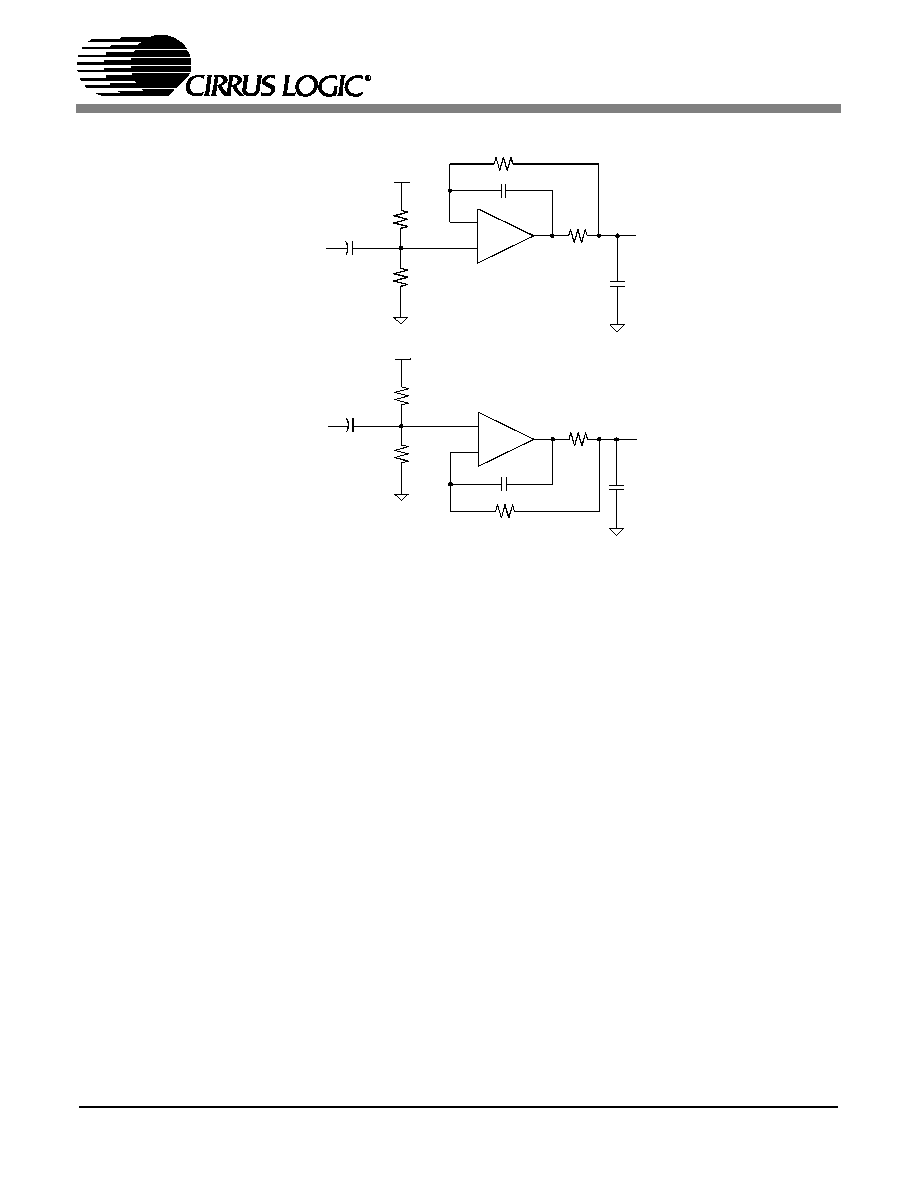
CS5340
19
4.6
Grounding and Power Supply Decoupling
As with any high resolution converter, the CS5340 requires careful attention to power supply and grounding arrange-
ments if its potential performance is to be realized. Figure 17 shows the recommended power arrangements, with
VA and VL connected to clean supplies. VD, which powers the digital filter, may be run from the system logic supply
or may be powered from the analog supply via a resistor. In this case, no additional devices should be powered from
VD. Decoupling capacitors should be as near to the ADC as possible, with the low value ceramic capacitor being
the nearest. All signals, especially clocks, should be kept away from the FILT+ and VQ pins in order to avoid un-
wanted coupling into the modulators. The FILT+ and VQ decoupling capacitors, particularly the 0.1 µF, must be po-
sitioned to minimize the electrical path from FILT+ and REF_GND. The CDB5340 evaluation board demonstrates
the optimum layout and power supply arrangements. To minimize digital noise, connect the ADC digital outputs only
to CMOS inputs.
4.7
Synchronization of Multiple Devices
In systems where multiple ADCs are required, care must be taken to achieve simultaneous sampling. To ensure
synchronous sampling, the MCLK and LRCK must be the same for all of the CS5340's in the system. If only one
master clock source is needed, one solution is to place one CS5340 in Master mode, and slave all of the other
CS5340's to the one master. If multiple master clock sources are needed, a possible solution would be to supply all
clocks from the same external source and time the CS5340 reset with the inactive (falling) edge of MCLK. This will
ensure that all converters begin sampling on the same clock edge.
100k
+
634
91
-
2200 pF
470 pF
COG
CS5340 AINL
AINL
COG
100k
4.7 uF
VA
100k
AINR
100k
4.7 uF
VA
634
91
+
-
470 pF
COG
CS5340 AINR
2200 pF
COG
Figure 21. CS5340 Recommended Analog Input Buffer
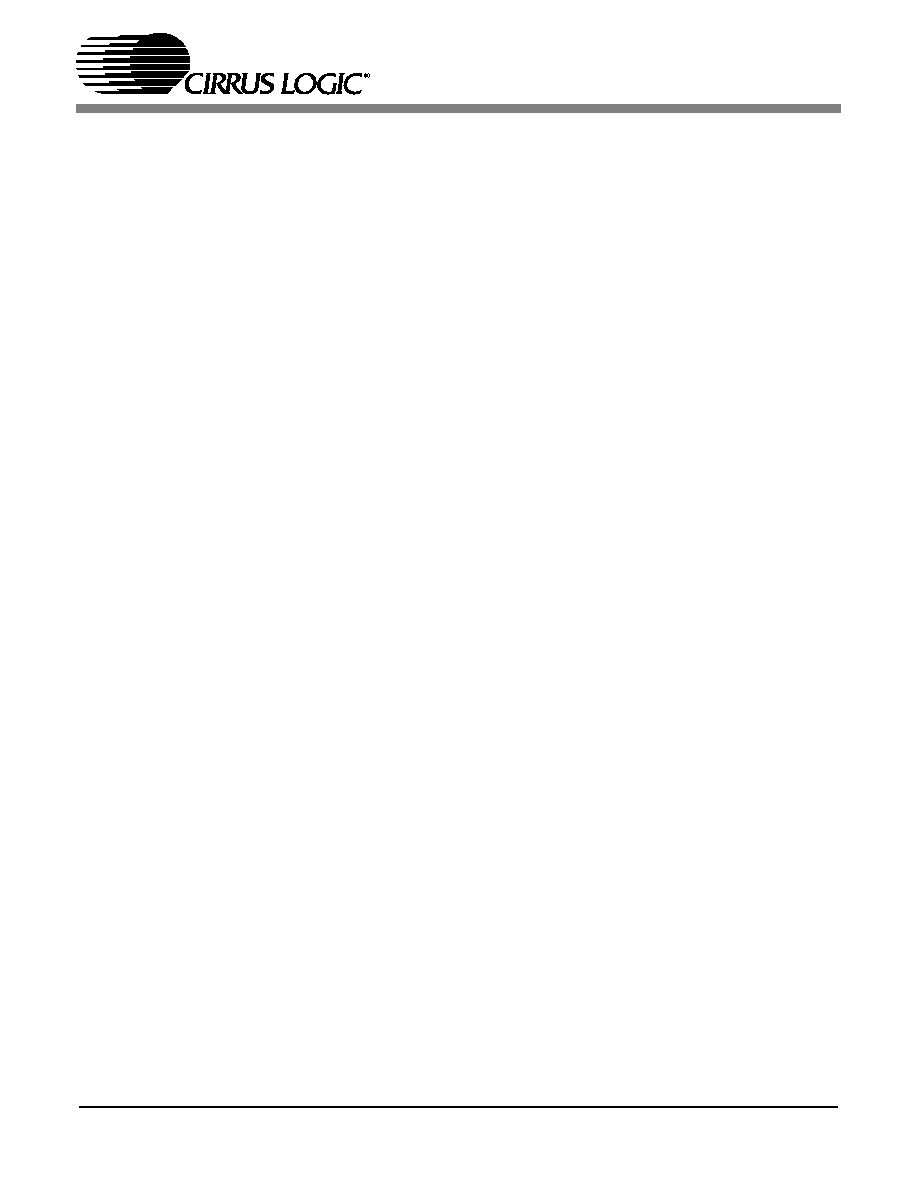
CS5340
20
5
PARAMETER DEFINITIONS
Dynamic Range
The ratio of the rms value of the signal to the rms sum of all other spectral components over the specified
bandwidth. Dynamic Range is a signal-to-noise ratio measurement over the specified bandwidth made
with a -60 dBFS signal. 60 dB is added to resulting measurement to refer the measurement to full-scale.
This technique ensures that the distortion components are below the noise level and do not affect the
measurement. This measurement technique has been accepted by the Audio Engineering Society,
AES17-1991, and the Electronic Industries Association of Japan, EIAJ CP-307. Expressed in decibels.
Total Harmonic Distortion + Noise
The ratio of the rms value of the signal to the rms sum of all other spectral components over the specified
bandwidth (typically 10 Hz to 20 kHz), including distortion components. Expressed in decibels. Measured
at -1 and -20 dBFS as suggested in AES17-1991 Annex A.
Frequency Response
A measure of the amplitude response variation from 10 Hz to 20 kHz relative to the amplitude response
at 1 kHz. Units in decibels.
Interchannel Isolation
A measure of crosstalk between the left and right channels. Measured for each channel at the converter's
output with no signal to the input under test and a full-scale signal applied to the other channel. Units in
decibels.
Interchannel Gain Mismatch
The gain difference between left and right channels. Units in decibels.
Gain Error
The deviation from the nominal full-scale analog input for a full-scale digital output.
Gain Drift
The change in gain value with temperature. Units in ppm/∞C.
Offset Error
The deviation of the mid-scale transition (111...111 to 000...000) from the ideal. Units in mV.
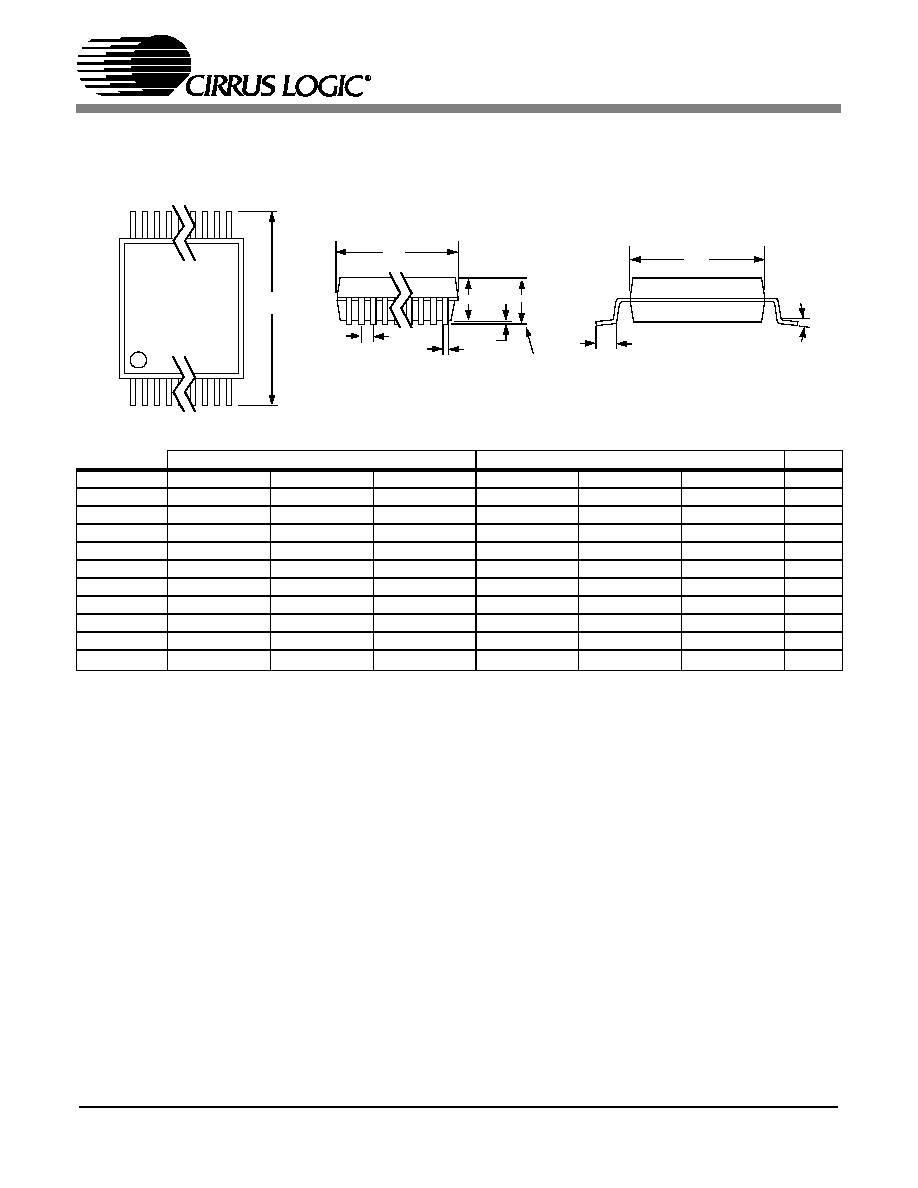
CS5340
21
6 PACKAGE DIMENSIONS
Notes: 1. "D" and "E1" are reference datums and do not included mold flash or protrusions, but do include mold
mismatch and are measured at the parting line, mold flash or protrusions shall not exceed 0.20 mm per
side.
2. Dimension "b" does not include dambar protrusion/intrusion. Allowable dambar protrusion shall be
0.13 mm total in excess of "b" dimension at maximum material condition. Dambar intrusion shall not
reduce dimension "b" by more than 0.07 mm at least material condition.
3. These dimensions apply to the flat section of the lead between 0.10 and 0.25 mm from lead tips.
INCHES
MILLIMETERS
NOTE
DIM
MIN
NOM
MAX
MIN
NOM
MAX
A
--
--
0.043
--
--
1.10
A1
0.002
0.004
0.006
0.05
--
0.15
A2
0.03346
0.0354
0.037
0.85
0.90
0.95
b
0.00748
0.0096
0.012
0.19
0.245
0.30
2,3
D
0.193
0.1969
0.201
4.90
5.00
5.10
1
E
0.248
0.2519
0.256
6.30
6.40
6.50
E1
0.169
0.1732
0.177
4.30
4.40
4.50
1
e
--
0.026 BSC
--
--
0.065 BSC
--
L
0.020
0.024
0.028
0.50
0.60
0.70
0∞
4∞
8∞
0∞
4∞
8∞
JEDEC #: MO-153
Controlling Dimension is Millimeters
16L TSSOP (4.4 mm BODY) PACKAGE DRAWING
E
N
1 2 3
e
b
2
A1
A2
A
D
SEATING
PLANE
E1
1
L
SIDE VIEW
END VIEW
TOP VIEW






















